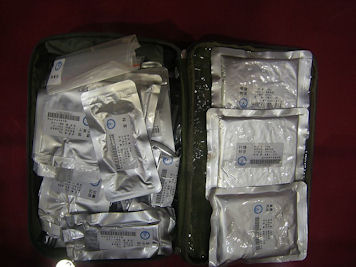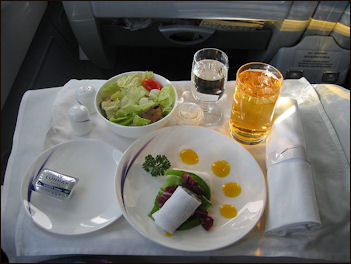FOOD IN CHINA
Chinese astronaut food
Rice is the dietary staple in most of the country. In the north and the west, where the climate is too dry to grow rice, wheat is the staple grain. Chinese dishes made with pork, chicken and freshwater fish such as carp, catfish, and bass are common. Other dishes are made from duck, pigeon, goose, eggs (from chicken, ducks and pigeons). Beef used to be considered an expensive luxury but is more common now. Seafood such shrimp, prawns, crab, lobster, clams, dried fish, squid, flounder, eels, dried jellyfish, preserved shark fins, seaweed, and sea cucumber are most widely available in the coastal areas such as Shanghai and Hong Kong.
Pork is a staple food in China, which has the largest porcine population in the world. Its 475 million pigs represent nearly half the global total. Some 70 percent of these animals are raised by small farmers, and mortality rates are high. In the town of Jiaxing alone nearly 750,000 pigs die of disease every year, estimates Mr. Lin. [Source: Peter Ford, Christian Science Monitor, March 14, 2013]
Common vegetables include spinach, cauliflower, celery, cucumbers, squash, white radish, green beans, snow peas, bean sprouts, water chestnuts, bamboo shoots, ginger, onions, tomatoes, peppers, eggplant, beets, mushrooms, potatoes and a wide variety of Chinese vegetables. Among the locally consumed fruits are plums, grapes, apples. limes, pineapples, oranges, bananas, tangerines, coconuts, mangos, papaya, watermelons, cantaloupes and wide variety of local fruits. In southern China you can find things like guavas, rambutans (lychee-like fruit) lychees, custard apple (zurzat), bread fruit, passion fruit, jerek (pomelo), starfruit, and durians (smelly but delicious).
Chinese food in China varies a great deal from region to region, with rice being the staple in the south and noodles the staple in north, although both rice and noodles are generally offered everywhere. Emily Ford wrote in The Times: “China’s eating habits are as diverse as Europe’s. What tastes good in Beijing may be unrecognizable 1,600 kilometers away in Chengdu...Tastes are fairly well ingrained. Chinese people like to slurp yoghurt through a straw and are suspicious of fizzy drinks. They do not have the West’s sweet tooth and cheese is about as appetizing as “mammal breast jelly,” as it translates in Mandarin.”
Percentage of income spent in China on food: 33.9 percent, compared to 6.9 percent in the U.S., 13 percent in Belgium and 45 percent in Kenya In 1994, 61 percent of household expenditures was spent on food, alcohol and tobacco, compared to 50 percent in Ethiopia and 13 percent in the United States).[Source: Washington State University ( wsu.edu/researcher/WSMaug ; Vox vox.com ]
See Separate Articles HISTORY OF FOOD IN CHINA factsanddetails.com ; FOOD, DRINKS AND CANNABIS IN ANCIENT CHINA factsanddetails.com ; WORLD'S OLDEST RICE IN CHINA factsanddetails.com ; CHINESE CUISINE factsanddetails.com ; MEAT IN CHINA factsanddetails.com ; HAIRY CRABS AND SEAFOOD IN CHINA factsanddetails.com ; VEGETABLES AND FRUIT IN CHINA factsanddetails.com ; SNACKS, DESSERTS AND SWEETS IN CHINA factsanddetails.com ; RICE, TOFU, DUMPLINGS AND NOODLES IN CHINA factsanddetails.com ; REGIONAL CHINESE CUISINES factsanddetails.com ; FAMOUS CHINESE FOODS AND DISHES WITH INTERESTING, FUNNY NAMES factsanddetails.com ; WEIRD FOODS IN CHINA factsanddetails.com ; BIRD'S NEST SOUP factsanddetails.com RESTAURANTS IN CHINA factsanddetails.com ; FAST FOOD AND FOOD DELIVERY BUSINESSES IN CHINA factsanddetails.com ; EATING CUSTOMS IN CHINA factsanddetails.com ; BANQUETS, PARTYING AND DRINKING CUSTOMS IN CHINA factsanddetails.com ; RICE: ITS HISTORY, AGRICULTURE, PRODUCTION AND RESEARCH factsanddetails.com; RICE AGRICULTURE IN CHINA factsanddetails.com; DUCKS, DAIRY COWS, FOIE GRASS AND LIVESTOCK IN CHINA factsanddetails.com; HOGS AND PIGS IN CHINA factsanddetails.com; FIRST CROPS IN CHINA factsanddetails.com ;
Websites and Sources: Wikipedia article Wikipedia ; Eating China Blog eatingchina.com/blog ; Imperial Food, Chinese Government site china.org.cn; Wikipedia article on History of Chinese Food Wikipedia ; Chopstix chopstix.com ; Asia Recipe asiarecipe.com ; Chinese Food Recipes chinesefood-recipes.com : Food Tours in China, China Highlights China Highlights
RECOMMENDED BOOKS: Chinese Diet and Nutrition “The China Study: The Most Comprehensive Study of Nutrition Ever Conducted and the Startling Implications for Diet, Weight Loss, and Long-Term Health” by T. Colin Campbell PhD, Thomas M. Campbell II MD, et al. Amazon.com; “The Tao of Healthy Eating: Dietary Wisdom According to Traditional Chinese Medicine” by Bob Flaws Amazon.com; “The Tao of Nutrition” by Maoshing Ni Amazon.com; “The Five Elements Cookbook: A Guide to Traditional Chinese Medicine with Recipes for Everyday Healing” by Zoey Xinyi Gong, Cassie Zhang (Photographer) Amazon.com; “Your Guide to Health with Foods & Herbs: Using the Wisdom of Traditional Chinese Medicine” by Yifang Zhang Amazon.com; “Chinese Business Dinner Culture: Mistakes to Avoid and Critical Must Do’s to Gain Face, Impress Decision Makers and Close More Deals” by Justin Trosclair Amazon.com
Chinese Fondness of Eating
business class airline food
on China Air
The Chinese love to eat and eating occupies a high place in Chinese life. It has been said that eating is "the principal Chinese means of celebrating an conceivable event.” Meals are a time to socialize and relax, and often the more people the merrier. The best restaurants are often referred to a “renao”—“hot and noisy.” A number of expression involve food names. A potsticker (“a gotte”) is person who leaves his comfortable state-owned-job. Eating tofu (“chi doufu”) is the act of cheating on one’s wife. One of the most common greetings is "”ni chi fan ma?”" (“have you eaten yet?”).
According to the Shanghai Daily: “Many Chinese sayings and proverbs refer to foods and alcohol. For example, jiu chi rou lin is widely used to describe a luxurious lifestyle. The four characters literally mean alcohol (jiu), a pool (chi), meat (rou) and woods (lin), indicating a scene of abundance in which alcohol/wine fills a pool and there are so many sticks of barbecued meat that they form a forest....In old times, people rose in revolution for lack of food. Officials tried to persuade their emperors to change policies through allegories about food and eating. Many tales about an emperor's wickedness or stupidity are told through his relationship to food, gluttony, for example. [Source: Shanghai Daily, February 23, 2009, China.org]
Eileen Yin-Fei Lo wrote in “Chinese Kitchen” (1999): “Food in China is tradition, folklore, mythology, ritual, and religious observance as well as nutrition. Nowhere else in the World is the daily table so entwined with, so much a part of, a people’s national fabric.” Angie Eagan and Rebecca Weiner wrote in “CultureShock! China”: Food in China is a central theme, ingrained intricately in life and language. When someone is feeling unwell, they are instructed to balance their body by eating ‘hot’ or ‘cold’ foods. Every festival, family gathering, business deal, celebration and significant event is marked by eating. Sacred alters are decorated with food offerings. Food defines life’s milestones, relationships and cadence in China. There are special foods for special occasions: mooncakes are given as gifts during the mid-Autumn festival, noodles should be eaten at birthdays to signify long life, and so on. [Source: “CultureShock! China: A Survival Guide to Customs and Etiquette” by Angie Eagan and Rebecca Weiner, Marshall Cavendish 2011]
Arthur Henderson Smith wrote in “Chinese Characteristics”, published in 1899: “ But a long experience of Chinese ways might not enable one to recall a single case where the acceptance of an invitation to eat was given with anything like reluctance. On the contrary, the art of securing such invitations is in China a "fine art, " and he who can always and everywhere put it into execution, is looked upon as a much more desirable model than the legendary " Superior Man, " whose thoughts are on too high a plane for food. It is impossible not to admire, and perhaps in a general way to envy the genuine gusto with which a party of Chinese sit down to a feast. They have enjoyed it in anticipation, as children enjoy Christmas, they enjoy it in its progress, however. long (and to an Occidental wearisome) it may be, and they enjoy it in retrospect, until the memory of it is' dimmed by another similar occasion. Hope has been defined as "a sentiment exhibited in the wag of a dog's tail while he is waiting for a bonei"; In our opinion, it is also finely manifested in that solemn moment when all the Chinese guests are gathered about the " eight fairy table, " with their, chopsticks aloft, in simultaneous pause, while the host callsout in notes of keenest joy, "Come, come, come, " upon which their bliss begins. There is, or ought to be, no doubt that the organs of digestion were intended to give pleasure in their exercise, and if this is the case, we repeat that the Chinese are here far nearer to the ideal of life than are we. [Source:“Chinese Characteristics” by Arthur Henderson Smith, 1894. Smith (1845 -1932) was an American missionary who spent 54 years in China. In the 1920s, “Chinese Characteristics” was still the most widely read book on China among foreign residents there. He spent much of his time in Pangzhuang, a village in Shandong.]
Chinese Diet
Rice and noodles are the dietary base, often eaten for breakfast, lunch, and dinner. Noodles are sometimes made from rice, but usually they are made from wheat or buckwheat. A traditional meal in northern China consists of rice or noodles, vegetables, soup and dumplings. A typical meal in rural southern China consists of soup, lotus root, Chinese radish, fish, cooked celery, beans, hot sauce and rice. The soup is made from cabbage and tofu stirred fried in a wok. A typical meal in rural villages is some steamed bread and a spicy soupy made with cabbage and potatoes. A peasant lunch consists of sugar cane, oranges, peanuts and salted duck eggs.
Amount of calories consumed each day by an average person in China: 2,990, compared to 1,590 in Eritrea and 3, 800 in the United States. In the 2000s, the average Chinese adult consumed 2,734 calories a day (compared to 3,603 calories per adult in the United States and 1,991 calories in Kenya). At that time grains made up 54.7 percent of the diet, compared to 24.8 percent in the United States.[Source: U.N. Food and Agriculture Organization, Wikipedia ]
Many Chinese believe that food has medicinal qualities. They regard the collagen found in shark fin soup for instance as good for the skin. The vinegar from dragon fruit is said to be good for the spleen, pork is said be effective in increasing qi and tencha Chinese teas, traditionalist believe, keeps allergies at bay.
Chinese eat about 50 kilograms of meat a year compared to 122 kilograms in the United States. Traditionally, Americans and Chinese ate about the same amount of pork, with Americans eating far more chicken and beef. Meat consumption in China increased from around eight kilograms per person a year in 1961 to around 50 kilograms in 2007. Between the 1980s and 2000s, vegetable consumption by average Chinese decreased by 50 percent while the consumption of meat increased 81 percent and eggs 51 percent. Meat production reached 76.5 million tons in 2005, a 5.7 percent increase from the previous year, and more than twice as much as the United States, and was expected to keep rising at a rate of 5 percent a year after that as disposable incomes rose and people could afford to eat more meat more often.
In 2012 China became the top groceries market: Chinese consumers bought $970 billion in groceries last year, compared with the U.S. total of $913.5 billion, according to U.K.-based grocery research firm IGD. [Source: Laurie Burkitt, Wall Street Journal, May 3, 2012]
The Chinese government controls the salt industry. Foodstuffs produced by government-controlled companies regularly found to have salt contents three to four times above the government's own guidelines. [Source: Iain Mills, Asia Times, April 21, 2010]
Chinese Eating Habits
Dinner is usually the main meal during the week. Lunch used to be and still in some rural areas and places where people take a long early afternoon break. On the weekend a large meal is eaten in the early afternoon. Many urban Chinese have adopted the American way of eating — a big breakfast, light lunch, and a big dinner. In northern China where wheat has traditionally been more commonly grown than rice, breakfast usually consists of noodles or wheat bread. In the south, many people start the day with rice porridge, or congee, served with shrimp, vegetables, and pickles. Lunch is similar to breakfast. The evening meal is the day's largest. Every meal includes soup, which is served as the last course. Chinese often have tea before and after their meals but drink nothing with their meals, Soup often serves the purpose of a drink. An evening snack of fruit is commonly eaten around 10:00pm. [Source: Eleanor Stanford, “Countries and Their Cultures”, Gale Group Inc., 2001]
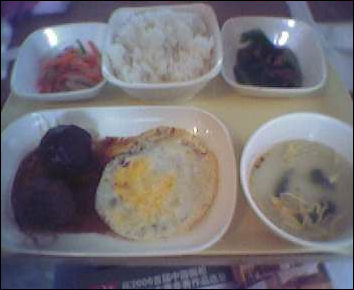
Huashan hospital food
Dumplings (“jiaozi”) are popular throughout China and they can be eaten for breakfast, lunch or dinner. They are usually made with ground pork, mixed with salt, sugar, sesame oil and other spices and wrapped in a flour skin and steamed to a gooey softness. They are often dipped in a sauce made with vinegar, soy sauce, hot chillies and ginger. Dumpling restaurants sometimes serve as places where people gather to socialize — like a tea house or coffee shop. Foreign investors are pouring money into frozen dumpling ventures, figuring that as Chinese become busier and richer they are more likely to turn to frozen dumplings for a quick dinner or snack.
Popular snacks sold on the streets and at sidewalk food stalls include fish balls, barbecued meats, noodle soups, dumplings in all shapes and sizes, and steamed bun with different fillings. Food stalls on the east coast in the summer offer braised eels and crayfish, roast duck, fried dumplings, pineapple on a stick, and bowls of snails and chili peppers. During the winter, vendors in Beijing sell hot noodle soup, eight-treasure porridge, roasted meats, sweet potatoes, roast mutton, fried doughsticks, steamed breads, “baozi” (steamed buns with a variety of vegetables and meats), and candied haw (small apple-like fruit that are covered with sticky candy and skewered on a stick). The Chinese also like to suck on chicken skin and eat chips.
Angie Eagan and Rebecca Weiner wrote in “CultureShock! China”: “ Delicious food can be found everywhere in China. Typically, morning begins with a quick stop at a streetside stall before beginning the tasks of the day. Here you can pick up a vegetable bun, a meat dumpling or a steaming cup of soya milk and a long doughnut stick to dip into it. The same stalls also serve lunchtime noodles, and will provide a small stool so customers can sit and quickly slurp down a bowl of noodles. The meal will end with a grand finale of tipping back the bowl and shovelling the last juice and noodle remnants into the mouth. Chinese are punctual about eating. At noon, chopsticks invade lunch boxes and restaurants are crowded and noisy. Tea is a constant throughout the day. A steaming cup is sitting on most desks, stashed away between seats in taxis, or tucked in a corner of the floor next to a chair. The afternoon is for snacks, savoury or sweet depending upon the person. At 6:00 pm sharp, an exodus begins toward home or restaurant in pursuit of dinner. [Source: “CultureShock! China: A Survival Guide to Customs and Etiquette” by Angie Eagan and Rebecca Weiner, Marshall Cavendish 2011]
Breakfast, Lunch, Dinner in China
Breakfast is generally eaten between 6:30am and 8:30am and consists of “zhou” (rice porridge or gruel), rice, pickled fish, soybean milk, soup, dumplings, steamed buns, 1000-year-old eggs and tea. “Congee”, also known as “jook”, is a popular breakfast food and hangover remedy. It is made with rice, chicken stock, and is usually seasoned with ginger, scallions, peanuts and bacon. In some places Chinese like to pine nuts, wolfberries, mung beans, jujubes and foxtail millet on their Chinese-style rice porridge. Most people eat breakfast at home. It's hard to find a restaurant that serves breakfast. In Beijing street venders serve up vegetables, wrapped in an omelette, which in turn is wrapped in a pancake. Some coffee shops have a set breakfast with a drink, toast, boiled egg and light food.
Lunch is generally eaten between 12:00noon and 1:30pm. Many people eat out, grabbing a quick meal or snack such as a bowl of soup or a stir-fried dish. People often eat noodles or noodle soup with vegetables for lunch. In some places in the south dim sum (an assortment of snack-sized delicacies) is popular. Dim sum is usually served between 11:00am and 2:00pm. By 2:00pm many restaurant workers are anxious to start their afternoon break and become impatient with afternoon diners.
Dinner is commonly y eaten between 6:00pm and 8:00pm. It generally an informal meal with meat or fish, rice. Main dishes made at home, include a variety of stir fried and wok dishes that vary from region to region but typically include a couple of meat or fish dishes, a couple of vegetable dishes, soup and rice.
Buying Food in China
It has been said that the Chinese make food choice decisions based on the Five Fs: fresh fish, fresh fruits, fresh vegetables, fresh meats and fresh seafood.
Chinese have traditionally liked their food very fresh. That is why you see so many live animals in the markets, Chinese like to see turtles that can still swim, chickens that can run, crabs that can pinch. Waiters at restaurants often show customers a live, flopping fish before it is thrown in a skillet. When shopping Chinese cooks look for fish with bright clear eyes and deep red gills; pork with a good ratio of meat to fat. They try to get vegetables that are as fresh as possible; get them from the market to the kitchen in as short of time as possible; and cut them at the last minute.
Food shopping in southern China has traditionally been done at “wet markets” — bustling food bazaars that truck in fresh vegetables and live animals every morning. Most customers have traditionally bought food and prepared it the same day. SARS, bird flu and food poisoning scares have raised safety concerns about these markets.
Most grains and edible oils are sold at prices set by the government. In some places Chinese still need to use ration cards to buy rice, grains and other staples.Cooking oil is an essential ingredient in Chinese cooking. In 2007 and 2008 there was a cooking oil crisis. Prices surged and supplies dried up in some areas. In November 2007 a large Carrefour grocery store in Chongqing offered a limited time sale of vegetable oil, at 20 percent off the normal price. In the stampede that ensured three people were killed and 32 were injured.
Shopping habits have changed as people have acquired refrigerators and microwave ovens and have started shopping at Western-style supermarkets. Consumers now buy more processed and frozen food and more dairy products than they used to. One customer at a Shanghai supermarket told the New York Times, “I come here more than 10 times a month. You can get everything here. And you can do all your shopping at once.”
Describing how high food prices have affected the life of an elderly family Fran Wang of AFP wrote, “The couple bought some vegetables, sticky rice and wrapping leaves to make the dumplings 10 days before Monday's Dragon Boat Festival — a pre-emptive move to avoid expected price rises as the holiday draws nearer. Li's pension provides her with 1,100 yuan (US$170) a month — far from enough to deal with spiraling prices. “My kids have to subsidize us,” she said. “We will have to depend on them in the future. I feel guilty.” [Source: Fran Wang, AFP, June 6, 2011]
Food and Health in China
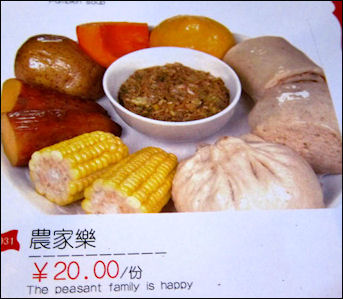
special at
Cultural Revolution restaurant
"No race on earth pays more attention than the Chinese to health, in terms of what they eat and drink," a representable of France's Remy Martin group in Hong Kong told the International Herald Tribune. One Chinese restauranteur told Reuter, "Our objective is to strike through our meals a balance between 'yin' and 'yang' in our body system."
A study in 1989 determined that Chinese eat 25 percent more calories than Americans, adjusted for height, and concluded that the Chinese were less likely to be overweight because they eat less fat and meat than Americas.
Rather than a food pyramid, Chinese are encouraged to eat in accordance with a food pagoda. In schools children are taught they should eat moderately polished cereals (whole grains), milk and bean products daily. They are also taught food should be distributed through three meals.
A survey in 1959 found that most Chinese didn’t get enough food and their diet consisted mostly of course grains, with rice and wheat making up only around 10 percent of their caloric intake. By 1982 people were getting enough to eat but their diet was still dominated by coarse grains.
Many people eat special foods because of their purported health benefits. Soups made with black chicken are supposed be good for one's skin. Fresh water fish with American ginseng is supposed to relieve fatigue. Crab and papaya are regarded as cooling dishes eaten in the summer.
In an effort to get Chinese to reduce their intake of salt five million small blue plastic spoons were distributed to households in Beijing with the idea that families would limit their intake of salt to one spoon a day ro reduce their chance of developing high blood pressure.
Organic Food in China
In recent years, the Chinese upper and middle class have begun to embrace organic farming as a source of safe food as China has seen an unending string of food scandals: melamine-injected milk, counterfeit baby formula, bacteria-infected vegetables, pollution-poisoned fish and even cooking oil recycled from sewage. Research by Japanese companies such as Asahi Beer indicates that many farmers lack the knowledge on how to use agricultural chemicals. [Source: William Wan, Washington Post, November 1, 2010]
A survey by the Chinese government in 2010 found that about 5 percent of produce examined was polluted with harmful substances in excess of government-set maximum levels. As is true with many things in China, there are reasonably good laws on the books for food safety but following and enforcing these laws is another story.
Organic milk can cost three times as much as regular milk but in some areas people are willing to pay the price to ensure the milk is free of chemicals and safe. Many ordinary Chinese take routine measures such as soaking vegetables in water to remove chemicals and ensure they are safe. On preparing vegetables such as winter melon and a housewife in Qingdao told the Yomiuri Shimbun, “I soak them in water for at least 30 minutes and often use salt to make sure they’re safe.”
Although organic produce stores are cropping up in Shanghai and Beijing, prices are high. Desperate for clean food at affordable prices, some Chinese families have formed cooperatives to buy directly from farmers — their own version of special supply. "There is not enough supply of organic food, there aren't so many farmers who really know how to produce organically, and if you found a farm, it is too expensive for ordinary people," said Liu Yujing, a Beijing homemaker who founded a 100-family cooperative last year. The mother of a 4-year-old girl, Liu was motivated by the revelations of melamine-tainted milk. "I know you can buy some organic food in shops, but I don't trust that either. We've heard a lot of them are fake." [Source: Barbara Demick, Los Angeles Times, September 16, 2011]
Among China's new echelon of super-rich, organic food has become a luxury fad in high-end supermarkets in recent years - a status symbol like the latest Gucci purse. Imagine, one Chinese yuppie told the Washington Post knowing exactly where your food came from and what went into it.
See Separate Article AGRICULTURE IN CHINA: CHALLENGES, SHORTAGES, IMPORTS AND AND ORGANIC FARMING factsanddetails.com
Overweight Chinese
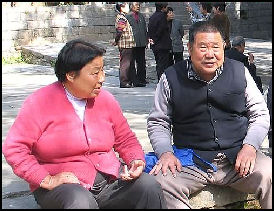 About 25 percent of Chinese are overweight or obese. Of all the developing countries, only Mexico has a rate of adult obesity increasing more.
About 300 million Chinese are considered overweight and 90 million (about 7 percent of the population) are obese (2006). The number of obese tripled as the economy grew sevenfold between 1992 and 2006. About 35 percent of adults in Beijing are overweight and 17 percent are obese, and the rate has been increasing at a rate of 10 percent a year. Obesity is defined as being 20 percent above the accepted body weight. Currently 10 percent of children are obese and their numbers increasing by 8 percent every year.
About 25 percent of Chinese are overweight or obese. Of all the developing countries, only Mexico has a rate of adult obesity increasing more.
About 300 million Chinese are considered overweight and 90 million (about 7 percent of the population) are obese (2006). The number of obese tripled as the economy grew sevenfold between 1992 and 2006. About 35 percent of adults in Beijing are overweight and 17 percent are obese, and the rate has been increasing at a rate of 10 percent a year. Obesity is defined as being 20 percent above the accepted body weight. Currently 10 percent of children are obese and their numbers increasing by 8 percent every year.
Many blame the problem on Western foods and a more sedentary lifestyle that has occurred as people have switched from farming and bicycles to cars and office jobs. Some blame the rising consumption of dairy products in a country where milk, cheese and butter have traditionally not been consumed, Harvard anthropologist James Watson told Reuters, “I’m personally convinced that this has much more to do with the obesity and health problems that are emerging than the usual scapegoat fast food...There’s a big change in terms of taste when people want ice cream throughout their lives.”
Overweight people are increasingly becoming common sights in China. Overweight children are bullied in school. Some have parents who are embarrassed to be seen in public with them, Fat adults are the butt of jokes and thinly-disguised whispers on the streets. As is true with short people in China, they are routinely denied places in schools and passed over for jobs and promotions that go to thin people. In the old days, being fat was a desirable trait. It signified wealth while being thin was equated with poverty. Back then many people only were able to eat meat a few times a month; many didn’t get enough to eat period. These days being obese is viewed in an unfavorable light. In 1990 the average Chinese ate 51 grams of fat per day — the equivalent amount of fat found in one KFC chicken pt pie and biscuit. Now they eat considerably more than that.
In recent years Chinese have become obsessed with slimming down and losing weight. Ads for appetite suppressants and slimming potions are everywhere. An A.C. Nielsen survey in 2004 found that two thirds of urban Chinese interviewed were concerned about losing weight, 80 percent exercised regularly and three quarters said that health was one of their main concerns. Weight reduction methods include acupuncture and eating copious amounts of cucumbers. Today there in an increasing demand for liposuction and bands placed around the stomach that restrict food intake and give a person a feeling of fullness.
See Separate Article OBESITY, MALNUTRITION AND EATING DISORDERS IN CHINA factsanddetails.com
Eating Less Meat in China to Combat Climate Change?
In 2016, as part of its pledge to bring down carbon emissions, the Chinese government outlined a plan to cut the country’s meat intake by 50 percent. It was a radical move that even some of the world’s most green countries are not willing to take. Nathanael Johnson wrote in Grist” “Nobody in the United States paid much attention when the Chinese government released new dietary guidelines” in May 2016. “But hidden within them is a provision that could slash carbon emissions from livestock, according to the group Climate Nexus citing a forthcoming report from WildAid. China is saying something simple and straightforward, something that the US government has never been able to bring itself to say: Eat less meat. [Source: Nathanael Johnson, Grist, Business Insider, May 28, 2016]
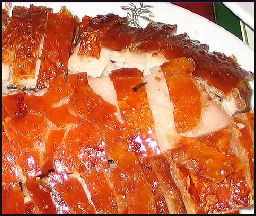
crispy pork
“If 1.3 billion Chinese people follow the guidelines and eat just 200 grams of meat and eggs a day — instead of increasing their meat consumption as expected — it would prevent a lot of greenhouse gas from entering the atmosphere. And when we say “a lot” we mean on the order of 1.5 percent of global emissions. That’s like zeroing out Mexico’s carbon emissions every year.
“The Chinese dietary guidelines don’t say anything about greenhouse gasses, only about health. The government issued them as part of a campaign against obesity. Even so, in a statement responding to the news, food and climate expert Jonathan Foley underlined the importance of dietary changes. “Reducing our meat consumption — especially red meat — even a little bit can have profound impacts on the future of the planet, ” Foley said.
Crystal Reid wrote in The Guardian: “The new guidelines, which called on citizens to consume just 40-75g of meat a day, were promoted with a series of public information adverts featuring the actor Arnold Schwarzenegger and director James Cameron. Since then there have been few other concrete steps taken”. In August 2020, President Xi Jinping launched a “clean plate campaign” aimed at reducing the “shocking and distressing” 40 percent of food that goes straight from Chinese dinner tables into the bin. Some commentators speculated that asking Chinese citizens to reduce their meat consumption was felt to be particularly unpopular. Alternative proteins are seen as a possible route forwards. In 2020 at the annual “two sessions” parliament, Sun Baoguo, a member of the Chinese People’s Political Consultative Conference, called for more investment in and regulation and promotion of artificial meat. [Source: Crystal Reid, The Guardian, March 9, 2021]
China Undergoing a Vegan Revolution?
Crystal Reid wrote in The Guardian: “The window of a KFC in the eastern Chinese city of Hangzhou hosts the image of a familiar mound of golden nuggets. But this overflowing bucket sporting Colonel Sanders’ smiling face is slightly different. The bucket is green and the nuggets within it are completely meat free. Over the last couple of years, after many years of rising meat consumption by China’s expanding middle classes for whom eating pork every day was a luxurious sign of new financial comforts, the green shoots of a vegan meat revolution have begun to sprout. Although China still consumes 28 percent of the world’s meat, including half of all pork, and boasts a meat market valued at $86 billion, plant-based meat substitutes are slowing carving out a place for themselves among a new generation of consumers increasingly alarmed by food crises such as coronavirus and African swine fever.[Source: Crystal Reid, The Guardian, March 9, 2021]
“China’s most cosmopolitan cities are now home to social media groups, websites and communities dedicated to meat-free lifestyles. VegeRadar, for example, has compiled comprehensive maps of vegetarian and vegan restaurants all across China. According to a report by the Good Food Institute, China’s plant-based meat market was estimated at $950 million in 2018 and projected to grow between 20 and 25 percent annually.
Vegetarianism has traditionally not been big in China. Many of those that eat a vegetarian diet did so because they were too poor to afford meat. People that choose vegetarianism voluntarily were generally considered wackos or were very religious Buddhists or Taoists. Yun Fanwei, a 25-year-old student from Shanghai, is one of a new breed of vegetarians hungry for more options. “I buy some of these fake meat products and a lot of them are pretty good. They don’t necessarily taste like meat, but it makes a nice change from tofu, ” she told The Guardian
Companies Try to Cash in on China’s Vegan Trend
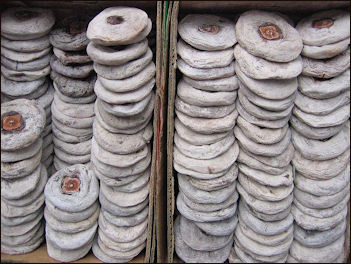
dried fruit
Crystal Reid wrote in The Guardian: “Some of the biggest international chains operating in China have been quick to bet on the growth of alternative meats. Burger King is offering an Impossible Whopper, and Starbucks is serving Beyond Meat pastas, salads and wraps. But domestic companies are setting up shop too, betting that state backing will come soon, not least because the government may see alternative proteins as a way to let citizens continue to have the “luxury” of meat while also moving towards its carbon-reduction goals. That optimism has led to several Chinese competitors entering the market alongside international powerhouses such as Cargill, Unilever and Nestlé, as well as the vegan meat poster-children Impossible and Beyond. [Source: Crystal Reid, The Guardian, March 9, 2021]
“OmniFoods, which launched in Hong Kong in 2018, is one of a band of regional startups jostling for market share, having recently opened a multi-brand vegan shop and restaurant in Shanghai and secured its signature product, OmniPork, in McDonald’s in Hong Kong and Aldi, White Castle and Starbucks on the mainland. The company, which plans to operate in 13 countries this year, also just completed its UK soft launch for Veganuary, during which OmniPork was turned into everything from scotch eggs to Korean bibimbap at participating restaurants.
“The OmniFoods founder, David Yeung, hopes the opening of a China-based factory next year will help bring down the price of his products. Plant-based proteins currently cost much more than their meat counterparts, a major barrier when it comes to getting China’s notoriously thrifty shoppers to make the switch. “Obviously minimising logistics and middle parties and creating economies of scale will have a big impact on the value chain. As we cut these expenses in China, we foresee a significant price drop, ” Yeung said.
“Shanghai-based Z-Rou produces a plant-based mince substitute which is already in the canteens of some of China’s top international schools, hospitals and businesses. Its CEO, Franklin Yao, is targeting opinion leaders and middle-class consumers who can afford to make conscious choices. “They would even be willing to pay more as they know they’re getting a healthier product that’s helping ensure the future of the planet their children are inheriting. That’s priceless.” Other China players include Zhenmeat, which makes plant-based beef, pork and crayfish, and Starfield, whose seaweed-based mince alternative has been turned into dishes at some of China’s leading restaurant chains.
“Yao admits the industry is still very small in China but he thinks meat-free substitutes will become mainstream very soon. “Chinese consumers are actively looking for more sustainable products. While the link between meat and the environment is still weak among the majority of the population, the interest is there and China learns fast.” But weaning people off meat may prove harder than some of these companies would like to think. “I’ve tried a vegetarian braised pork dish before but it’s not the same as real meat, ” said 64-year-old retiree Bao Gege. “The taste, texture and nutritional values are not comparable. I wouldn’t try it again, even if it was cheaper than meat.”
Eating and Cooking Alone in China in the Leftover Woman Era
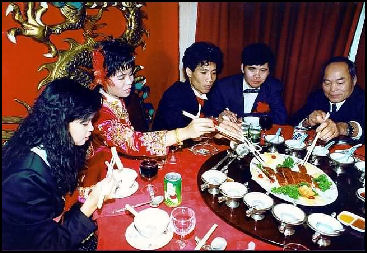
Wedding feast
Jiayang Fan wrote in The New Yorker, “The first time I ate at a restaurant by myself, I live-tweeted the experience. “Hot-potting alone!” I enthused, posting a photo I’d taken of a burbling electric pot, ringed by plates of enoki mushrooms, plump squares of tofu, and green-bean-infused vermicelli noodles. (If Chinese food fosters communal dining more aggressively than other types of cuisine, then hot pot—think fondue with chicken broth and chili peppers rather than melted cheese—forcefully commands it.) Sitting companionless at a table patently designed for four, I composed the portrait of my meal with some care, both to entice my viewers and to deride my circumstances. “Desperate times call for desperate measures!” I supplied as an additional caption before picking up my chopsticks. Then I hastily put them down again, to link the post to Facebook and Instagram.[Source: Jiayang Fan, The New Yorker, January 14, 2015 ***]
“Yanni Cai, the author of a new book called “Eating Alone,” might understand the impulse. The book, published last fall in China, is a follow-up to a series of short videos, by the same name, “dedicated to the art of cooking for yourself.” Cai, a thirty-something former magazine editor who lives in Shanghai and is unmarried—or, in the ugly parlance of practical-minded Chinese, a “leftover woman”—came up with the idea two years ago, after one too many embarrassing experiences at restaurants where the staff disdained her solo patronage and refused to pack up her leftovers. Rude, perhaps, but not uncommon in a culture where cooking (and dining) is an inherently social function, centered upon the idea of community. For millennia, the most basic of Chinese meals have involved “three main dishes plus a soup,” a spread that only makes sense for a table of three people or more. It’s no wonder that a perennial staple of stir-frys—a merry medley of beef, chicken, pork and vegetables—is named “happy family.”
“At first, I made French fries and ate fast food,” Cai writes in the book’s preface. “As time wore on, I wanted to cook for myself, but didn’t know where to begin.” So she did what so many of us have tried: she sought help on the Internet. Cooking instructionals on the video-sharing Web site Vimeo offered her useful techniques and inspiration. Eventually, she decided to make her own. Her three-minute creations—which have attracted close to eight million page views on Youkou, the Chinese equivalent of YouTube—are stylistically indistinguishable from their English-language muses: extremely pretty, with ambient music and a life-style-magazine sheen. Some open with a premise—a single mother shopping with a toddler strapped to her back, or a husband waking up famished next to his still-sleeping wife; others launch expeditiously into expert chopping and dicing. It’s the sort of aspirational food porn that a young person, bored and alone, with nothing but a WiFi connection for company, might mindlessly click through while eating a bowl of microwaved ramen—which is exactly what Cai discourages. “A person who is eating alone cannot do so casually. He cannot simply make do,” Cai admonishes. “Food has healing powers that exceed the imagination. It will nourish you, fill your stomach but more importantly, it can heal your loneliness.”
“But in the world’s biggest and busiest economy—where striving urbanites and struggling migrant workers alike regularly work seventy-hour weeks, and where rapidly changing life styles perennially outpace the evolution of social norms—is cooking elaborate meals for oneself all that realistic? With her videos and her book, Cai offers a way to avoid feeling ostracized, but she fails to question why a person dining solo in China is made to feel ostracized in the first place. As a coffee-table topper, her epigrammatic prescriptions and sepia-toned photos are quaint, and she writes that she intends to share “a mode of existence and attitude about life.” But she does not go on to explain what that means, exactly, and she does little to address the cultural context in which eating alone in public—when one does not have the luxury of a kitchen, or the time to prepare an elaborate meal—might be appropriate or even necessary. ***
“Instead, Cai’s “recipe stories” depict smartly turned-out men and women concocting preternaturally photogenic meals from an almost parodic, parallel universe. One story, centered on the summer waffle—a decadent confection of strawberries, cream, and sugar—follows a silken-haired young woman taking herself out on a sumptuous picnic set on a patch of grass as artificial-looking as the story’s premise. Another popular episode features a Cantonese clay-pot classic requiring such a baroque set-up that it’s difficult to imagine anyone doing so without professional culinary aspirations. Very few characters in Cai’s charmed universe seem to be functioning under any sort of time constraint. (Fewer still seem to contemplate cooking in bulk, surely a more sensible option for the lone chef, if infinitely less pleasing on the small screen.) ***
“There’s a reason Cai’s videos and book are as delectable as the dishes they feature; they, too, are made for consumption, much more so than imitation. They may, ostensibly, seek to teach, but the more necessary lesson, perhaps unbeknownst to even the teacher herself, can’t be taught in the kitchen. What’s needed, most pressingly, is the acceptance of a more individualized and independent way of living, befitting a changing China. Societal permission for solo diners to consume unselfconsciously—to savor solitude without fear of discrimination and the anxiety of judgment. “I’m watching this alone,” a commenter wrote wryly beneath the video of the summer waffle. “It relaxes me and loosens my heart.” To be alone isn’t always to be lonely. Sometimes, a strawberry waffle is all the companionship you need. ***
China’s Anti-Food-Waste Campaign
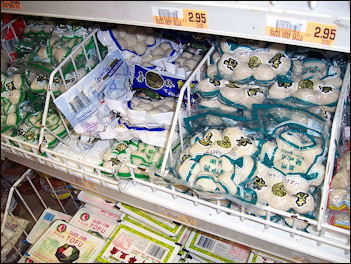
processed meatballs
In 2020 the Chinese government proposed legislation to curb food waste. Sixth Tone reported: The current draft law includes provisions requiring catering service providers to remind consumers to avoid food waste, and to actively dissuade them from ordering more dishes than they can possibly finish — a common way to show hospitality. Restaurants should offer different portion sizes and are allowed to charge consumers for having to dispose of their leftovers, the document says. The draft document for the law was submitted for review by the Standing Committee of the National People’s Congress, China’s top legislative body.[Source: Li You Sixth Tone, December 22, 2020]
“The draft urges local government departments to publicize information about their anti-food waste campaigns every year, and further tightens regulations on banquets organized by government departments and state-owned enterprises.“The legislation may raise anti-food waste awareness, ” He Pinghua, who teaches food economy at Huazhong Agricultural University, told Sixth Tone. The professor added, however, that “wasting food is still an ethical issue, ” and as such it’s difficult to police from a legal standpoint. “For example, how should over-ordering be defined? This requires further clarification of standards and supporting laws, ” He said.
In August 2020, Xi Jinping launched a the “Clean Plate Campaign” to combat food waste. In October of that year, “anti-waste and cherish food” was also written into a revision of China’s law on the protection of minors, saying children should be taught not to waste food. But in 2020 Chinese farmers were hit by flooding and typhoons, and the timing of the anti-food waste campaign engendered doubts about the country’s food security. Through it all, officials have maintained that there is an ample supply of food. “Beyond lowering demand, the “Clean Plate Campaign” also helps reduce strain on China’s food waste treatment facilities, whose capacity has proved insufficient after many Chinese cities started enforcing waste-sorting policies.
Half-Naked Sushi Models and Other Food Fads in China
In 2017, NextShark and the New York Post reported: “A video of a sushi model striking back at a grabby customer has gone viral on Chinese social media. The incident took place at a restaurant in Taiyuan, China, where guests picked fish rolls off half-naked women’s bodies’ with chopsticks. But when one customer allegedly did something “unspeakable” with his chopsticks to a model, she leapt up and shoved him. [Source: Christian Gollayan, New York Post, Published May 31, 2017
Videos of people eating ridiculous amounts of food — called ‘mukbang’ videos — were all the rage in China in 2020 but drew a critical eye from the Chinese government when it launch its anti-food waste campaign. Sixth Tone reported: “Binge-eating, or mukbang, videos were a popular form of online entertainment until Xi’s call to reduce food waste in August 2020 put the category in the authorities’ crosshairs. State media criticized such videos, an industry body announced a ban on them, and they mostly disappeared from Chinese sites. And in the wake of Xi’s comments, many local catering associations announced limits on how many dishes could be served during group meals. The draft law to limit food waste proposed in 2020 suggests, among other measures, that media content producers who promote overeating be given hefty fines of up to 100,000 yuan ($15,300) and have their business operations suspended..[Source: Li You Sixth Tone, December 22, 2020]
Image Sources: Beifan.com; Nolls China website http://www.paulnoll.com/China/index.html ; Asia Obscura
Text Sources: New York Times, Washington Post, Los Angeles Times, Times of London, National Geographic, The New Yorker, Time, Newsweek, Reuters, AP, Lonely Planet Guides, Compton’s Encyclopedia and various books and other publications.
Last updated October 2021

